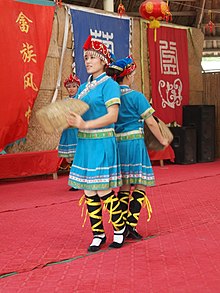
Back ཧྲེ་མི། Tibetan She Catalan Siă-cŭk CDO She German She Spanish She etnia Basque Shet Finnish She French 畬人 GAN Chhià-chhu̍k HAK
 She traditional dance performance in Huanglongyan (黄龙岩), Heyuan, Guangdong | |
| Total population | |
|---|---|
| 709,592 (2000) | |
| Regions with significant populations | |
| Languages | |
| Predominantly She Chinese, Standard Chinese (lingua franca) and other Sinitic languages. A minuscule minority speak the She language in Zengcheng, Boluo County, Huidong County and Haifeng County in Guangdong Province. | |
| Religion | |
| She indigenous religion (She Wuism),[1] Buddhism | |
| Related ethnic groups | |
| Yao, Miao, Hakka Han |
| She people | |||||||||||||||||||||||||
|---|---|---|---|---|---|---|---|---|---|---|---|---|---|---|---|---|---|---|---|---|---|---|---|---|---|
| Chinese | 畲族 | ||||||||||||||||||||||||
| |||||||||||||||||||||||||
The She people (Chinese: 畲; She Chinese: [sa˦]; Cantonese: [sɛː˩], Fuzhou: [sia˥]) are an ethnic group in China. They form one of the 56 ethnic groups officially recognized by the People's Republic of China.
According to the 2021 China Statistical Yearbook, the total population of the She was 746,385, including 403,516 males and 342,869 females. The She are the largest ethnic minority in Fujian, Zhejiang, and Jiangxi Provinces. They are also present in the provinces of Anhui and Guangdong. Some descendants of the She also exist amongst the Hakka minority in Taiwan.
- ^ 从科仪唱本看畲族的巫术文化. mzb.com.cn.